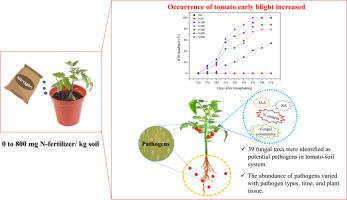Applied Soil Ecology ( IF 4.8 ) Pub Date : 2022-03-05 , DOI: 10.1016/j.apsoil.2022.104445 Jingjing Bi 1 , Alin Song 1 , Shidong Li 2 , Mingshun Chen 3 , Yanan Wang 4 , Sai Wang 1 , Zhiyuan Si 1 , Enzhao Wang 1 , Jiayin Zhang 1 , Bismark Asante-Badu 1 , Marie Claire Njyenawe 1 , Qianru Zhang 1 , Piao Xue 5 , Fenliang Fan 1

|
Nitrogen (N) is an essential element for plant growth and development. N levels in soil may also impact plant disease occurrence. However, the physiological and microbial mechanisms between N levels in soil and plant disease occurrence are not quite clear at present. In this study, we examined the impact of seven urea levels (0 to 800 mg kg−1 soil) on the physiology of tomato (Lycopersicon esculentum) and fungal disease occurrence. Our results showed that the disease incidence and index caused by a tomato early blight pathogen (Alternaria alternata) increased with increasing N levels. The disease index and percentage of disease incidence were positively correlated with N content, indole-3-acetic acid (IAA) and salicylic acid (SA) in plants, but negatively correlated with fungal community diversity. In addition to pathogens (A. alternata) that cause known early blight, 39 other fungal taxa were also identified as plant pathogens in tomato roots, leaves, and soil, the dominant putative pathogens included Ceratobasidiaceae sp., Fusarium oxysporum, Macrophomina phaseolina, Nectriaceae sp., Podosphaera fusca and Trichoderma viride. N levels affected the distribution and dynamics of the fungal pathogen community, such as the abundance of Fusarium oxysporum increased by 33% on roots from days 25 to 35. Our results demonstrated that plants undergo complex disease risk from different pathogens under different N levels, highlighting a need for proper N management, and integration of nutrient management as a disease control approach for sustainable agricultural production.
中文翻译:

沿土壤氮梯度的植物生理学、微生物群落和多种真菌病害的风险
氮(N)是植物生长发育的必需元素。土壤中的氮含量也可能影响植物病害的发生。然而,目前土壤中氮水平与植物病害发生之间的生理和微生物机制尚不十分清楚。在这项研究中,我们检查了七种尿素水平(0 至 800 mg kg -1土壤)对番茄(Lycopersicon esculentum)生理和真菌病发生的影响。我们的研究结果表明,番茄早疫病病原体(Alternaria alternata )引起的疾病发病率和指数) 随着 N 水平的增加而增加。病害指数和发病率与植物中氮含量、吲哚-3-乙酸(IAA)和水杨酸(SA)呈正相关,与真菌群落多样性呈负相关。除了引起已知早疫病的病原体(A. alternata)外,番茄根、叶和土壤中还鉴定出其他 39 种真菌类群作为植物病原体,主要的推定病原体包括Ceratobasidiaceae sp.、Fusarium oxysporum、Macrophomina phaseolina 、Nectriaceae sp., Podosphaera fusca和Trichoderma viride. N 水平影响真菌病原体群落的分布和动态,例如从第 25 天到第 35 天,根上尖孢镰刀菌的丰度增加了 33%。我们的研究结果表明,在不同 N 水平下,植物面临来自不同病原体的复杂疾病风险,突出需要进行适当的氮管理,并将养分管理整合为可持续农业生产的疾病控制方法。











































 京公网安备 11010802027423号
京公网安备 11010802027423号